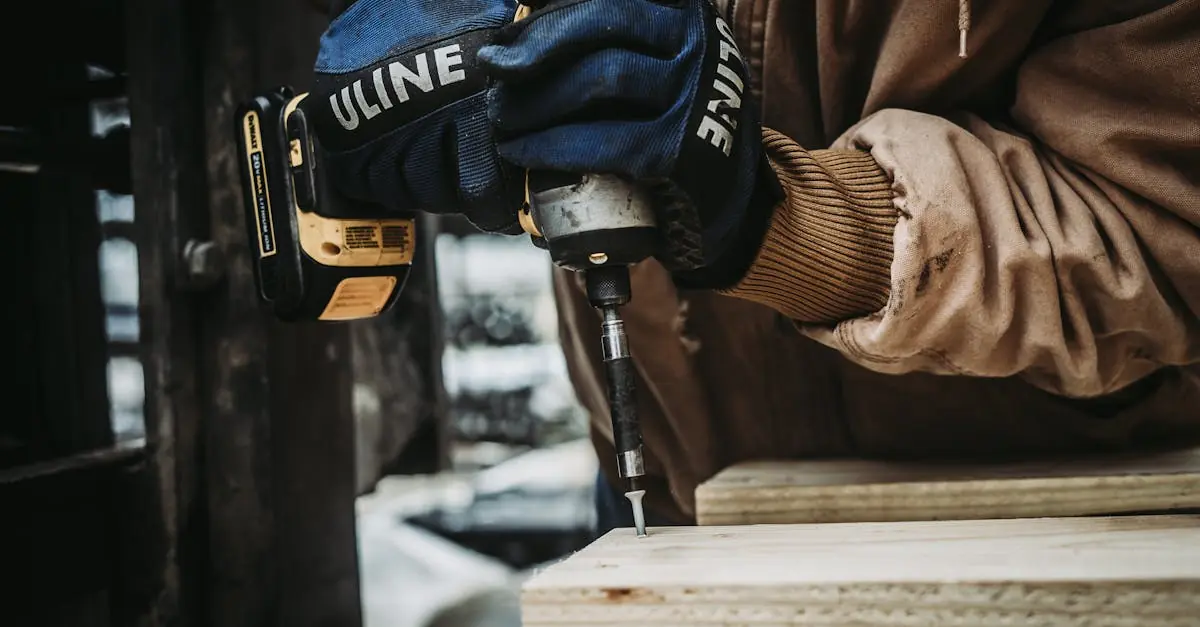Looking to turn your woodworking hobby into a cash cow? DIY wood projects aren’t just about creating something beautiful; they’re also a fantastic way to pad your wallet. Imagine transforming a few planks into stunning home decor or practical furniture pieces that have buyers lining up at your door. With a little creativity and elbow grease, anyone can become the next woodworking sensation.
From quirky shelves to charming garden planters, the possibilities are endless. Not only will you impress friends and family with your skills, but you’ll also have the chance to make some serious cash while doing what you love. So grab your tools, unleash your inner craftsman, and get ready to carve out a niche in the bustling world of DIY wood projects. Who knew making money could be this much fun?
Table of Contents
ToggleUnderstanding DIY Wood Projects
DIY wood projects provide creative opportunities for woodworking enthusiasts, resulting in attractive home decor and practical furniture.
Benefits of DIY Wood Projects
Engaging in DIY wood projects offers multiple benefits. First, individuals tap into their creativity, transforming ideas into tangible products. Crafting unique items provides a sense of accomplishment, while also allowing for the potential of additional income. Sellers attract customers seeking personalized pieces often unavailable in stores. Furthermore, working with wood fosters mindfulness, promoting relaxation and stress relief. Lastly, sustainable practices emerge from utilizing reclaimed wood, appealing to eco-conscious buyers.
Skills Required for Success
Success in DIY wood projects demands specific skills. First, basic woodworking techniques are essential, including measuring, cutting, and assembling. Familiarity with tools like saws, drills, and sanders proves beneficial. Creativity plays a pivotal role, allowing artisans to innovate and design unique projects. Attention to detail ensures quality craftsmanship, enhancing the appeal of finished products. Additionally, project planning and time management maximize efficiency, enabling consistent output. Lastly, marketing skills increase visibility, attracting potential buyers in competitive markets.
Popular DIY Wood Projects to Sell
Crafting wood projects for sale offers a fantastic opportunity for creative individuals to monetize their skills. Focus on these popular types of projects that attract buyers.
Furniture Ideas
Creating custom furniture pieces holds high demand. Shedding light on tables, chairs, and benches allows for unique design expressions. They can tailor dimensions and styles to match buyers’ preferences. Adding personal touches, like painted finishes or mixed materials, enhances appeal. Customers appreciate handmade items that fit their spaces perfectly. Building items such as console tables or nightstands converts woodworking skills into sales.
Home Decor Items
Home decor items generate interest for their aesthetic appeal. She can craft items like wooden signs, picture frames, and shelves. Personalized decor captures buyers’ attention through customization options. Incorporating popular themes, colors, and designs makes these items more marketable. Wall art and decorative crates offer functional beauty, making them desirable. Shoppers love unique, handcrafted pieces that elevate their home ambience.
Outdoor Projects
Outdoor projects thrive in popularity among homeowners. Planters, birdhouses, and garden furniture present lucrative options. Each item can reflect buyers’ gardening style and interests. Weather-resistant materials ensure durability, making these projects appealing for outdoor use. Building attractive picnic tables or patio chairs adds to the outdoor comfort. Customers seek well-crafted items that enhance their outdoor spaces and appeal to their lifestyles.
How to Market Your DIY Wood Projects
Marketing DIY wood projects effectively enables artisans to reach potential buyers efficiently. Various strategies can maximize visibility and sales.
Setting Up an Online Store
Creating an online store effectively showcases DIY wood projects. Choose platforms like Etsy, Shopify, or Amazon Handmade to reach a larger audience. Ensure high-quality images accompany each product listing. Clear descriptions highlight unique features and craftsmanship. Set competitive prices based on market research while considering material costs and labor. SEO optimization enhances searchability; incorporate relevant keywords in titles and descriptions. Regularly monitor inventory to maintain a consistent supply. Engage with customers through timely responses to inquiries. Offer promotions or discounts to attract new buyers and retain existing ones.
Utilizing Social Media
Social media serves as a powerful marketing tool for DIY wood projects. Platforms like Instagram, Facebook, and Pinterest allow artisans to share visuals of their work. Create engaging posts that showcase products, behind-the-scenes processes, and completed projects. Use relevant hashtags to increase visibility and attract followers interested in woodworking. Collaborating with influencers can broaden reach and introduce products to new audiences. Additionally, hosting contests or giveaways encourages interaction and fosters a sense of community. Regular posting keeps potential buyers engaged and informed about new offerings. Encourage customer feedback and testimonials to build trust and credibility in the brand.
Pricing Your DIY Wood Projects
Setting competitive prices for DIY wood projects involves a careful evaluation of various factors. Understanding material costs, labor, and time spent helps in determining the right pricing strategy.
Cost of Materials
Material costs directly influence the pricing of DIY wood projects. Gathering information on prices from local suppliers aids in determining overall expenses. Wood types, finishes, and hardware each contribute differently to total material costs. For example, hardwoods typically cost more than softwoods, affecting project pricing significantly. It’s essential to factor in the cost of additional tools or supplies that enhance the finished product. Keeping detailed records of material expenses ensures accurate pricing and helps achieve better profit margins.
Labor and Time Considerations
Labor and time considerations play a crucial role in setting project prices. Individuals often underestimate the hours spent crafting their pieces. Calculating an hourly wage for labor provides a clearer perspective on pricing. For instance, if a project takes ten hours and an artisan values their time at $15 per hour, labor costs amount to $150. Additionally, adjustment for intricate designs or complicated techniques may warrant higher pricing. Understanding one’s skills and the time invested ensures fair compensation for creativity and effort.
Embracing DIY wood projects offers a fulfilling path to creativity and potential income. Artisans can transform their passion into profit by crafting unique items that resonate with buyers. The journey not only enhances woodworking skills but also fosters a sense of achievement and mindfulness.
By tapping into various project ideas and utilizing effective marketing strategies, creators can successfully navigate the competitive landscape. Understanding pricing and material costs ensures fair compensation for their hard work. With dedication and innovation, anyone can thrive in the world of DIY woodworking, turning their creations into cherished products that enhance homes and gardens.




